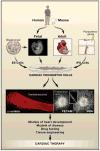Origins and fates of cardiovascular progenitor cells
- PMID: 18295570
- PMCID: PMC2507768
- DOI: 10.1016/j.cell.2008.02.002
Origins and fates of cardiovascular progenitor cells
Abstract
Multipotent cardiac progenitor cells are found in the fetal and adult heart of many mammalian species including humans and form as intermediates during the differentiation of embryonic stem cells. Despite similar biological properties, the molecular identities of these different cardiac progenitor cell populations appear to be distinct. Elucidating the origins and lineage relationships of these cell populations will accelerate clinical applications such as drug screening and cell therapy as well as shedding light on the pathogenic mechanisms underlying cardiac diseases.
Figures


Similar articles
-
Endogenous cardiac stem cells.Prog Cardiovasc Dis. 2007 Jul-Aug;50(1):31-48. doi: 10.1016/j.pcad.2007.03.005. Prog Cardiovasc Dis. 2007. PMID: 17631436 Review.
-
Isolation and expansion of resident cardiac progenitor cells.Expert Rev Cardiovasc Ther. 2007 Jan;5(1):33-43. doi: 10.1586/14779072.5.1.33. Expert Rev Cardiovasc Ther. 2007. PMID: 17187455 Review.
-
The stem cell movement.Circ Res. 2008 May 23;102(10):1155-68. doi: 10.1161/CIRCRESAHA.108.175158. Circ Res. 2008. PMID: 18497316 Review.
-
Resident progenitors and bone marrow stem cells in myocardial renewal and repair.Nat Clin Pract Cardiovasc Med. 2006 Mar;3 Suppl 1:S83-9. doi: 10.1038/ncpcardio0415. Nat Clin Pract Cardiovasc Med. 2006. PMID: 16501639 Review.
-
Heart to heart: cardiospheres for myocardial regeneration.Heart Rhythm. 2012 Oct;9(10):1727-31. doi: 10.1016/j.hrthm.2012.07.012. Epub 2012 Jul 17. Heart Rhythm. 2012. PMID: 22813578 Review.
Cited by
-
SWI/SNF protein component BAF250a regulates cardiac progenitor cell differentiation by modulating chromatin accessibility during second heart field development.J Biol Chem. 2012 Jul 13;287(29):24255-62. doi: 10.1074/jbc.M112.365080. Epub 2012 May 23. J Biol Chem. 2012. PMID: 22621927 Free PMC article.
-
Isolation, Characterization and Differentiation of Mouse Cardiac Progenitor Cells.Methods Mol Biol. 2018;1842:183-191. doi: 10.1007/978-1-4939-8697-2_12. Methods Mol Biol. 2018. PMID: 30196409 Free PMC article.
-
Emergence of Three Dimensional Printed Cardiac Tissue: Opportunities and Challenges in Cardiovascular Diseases.Curr Cardiol Rev. 2019;15(3):188-204. doi: 10.2174/1573403X15666190112154710. Curr Cardiol Rev. 2019. PMID: 30648518 Free PMC article. Review.
-
Is stem cell-based therapy going on or out for cardiac disease?Korean Circ J. 2009 Mar;39(3):87-92. doi: 10.4070/kcj.2009.39.3.87. Epub 2009 Mar 25. Korean Circ J. 2009. PMID: 19949592 Free PMC article.
-
In vitro differentiation of rat embryonic stem cells into functional cardiomyocytes.Cell Res. 2011 Sep;21(9):1316-31. doi: 10.1038/cr.2011.48. Epub 2011 Mar 22. Cell Res. 2011. PMID: 21423272 Free PMC article.
References
-
- Anderson D, Self T, Mellor IR, Goh G, Hill SJ, Denning C. Mol Ther. 2007;15:2027–2036. - PubMed
-
- Assmus B, Honold J, Schachinger V, Britten MB, Fischer-Rasokat U, Lehmann R, Teupe C, Pistorius K, Martin H, Abolmaali ND, et al. N Engl J Med. 2006;355:1222–1232. - PubMed
-
- Beqqali A, Kloots J, Ward-van Oostwaard D, Mummery C, Passier R. Stem Cells. 2006;24:1956–1967. - PubMed
-
- Beltrami AP, Barlucchi L, Torella D, Baker M, Limana F, Chimenti S, Kasahara H, Rota M, Musso E, Urbanek K, et al. Cell. 2003;114:763–776. - PubMed
Publication types
MeSH terms
Grants and funding
LinkOut - more resources
Full Text Sources
Other Literature Sources
Medical

